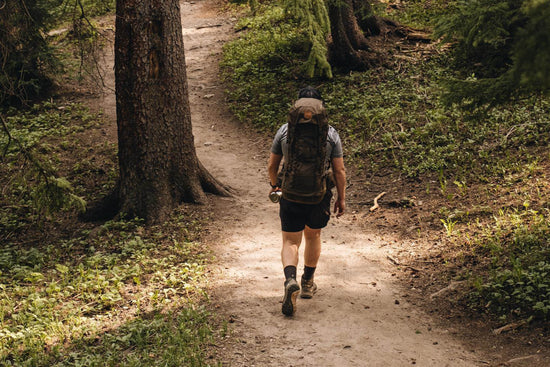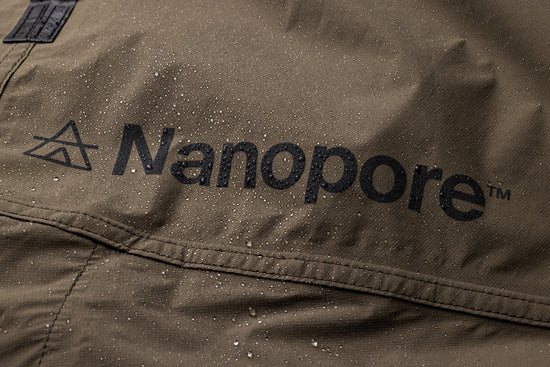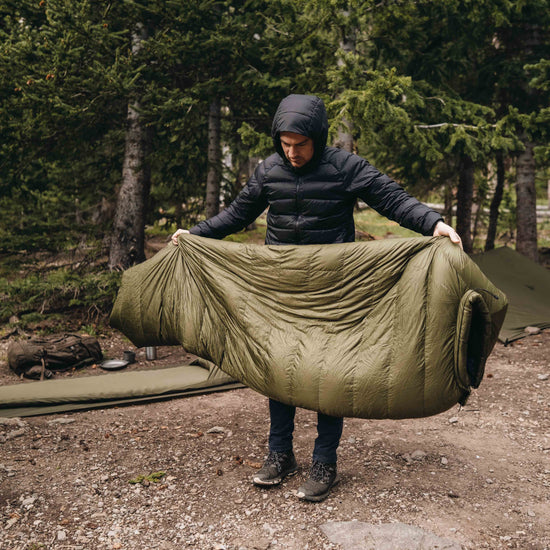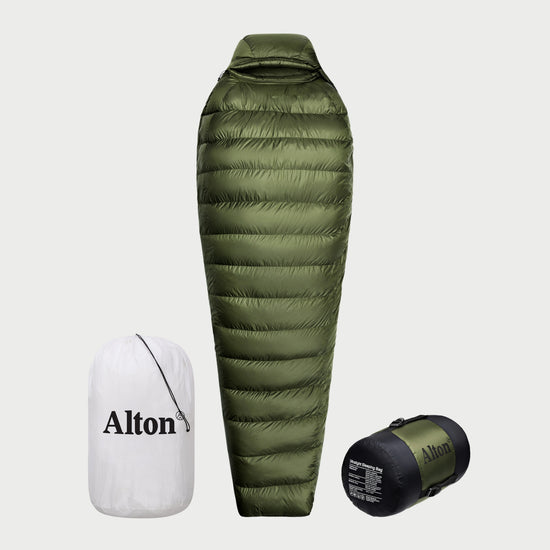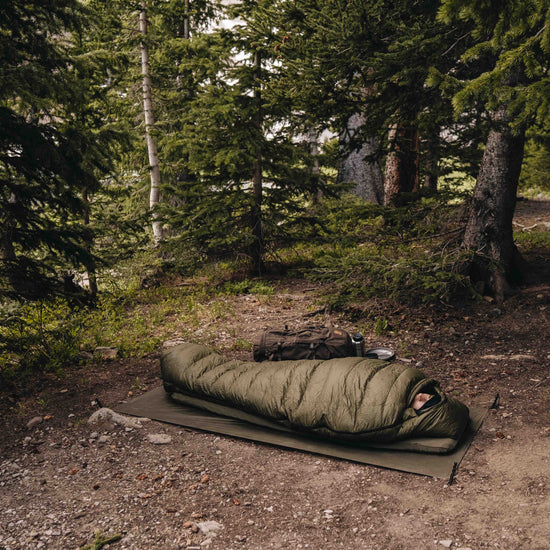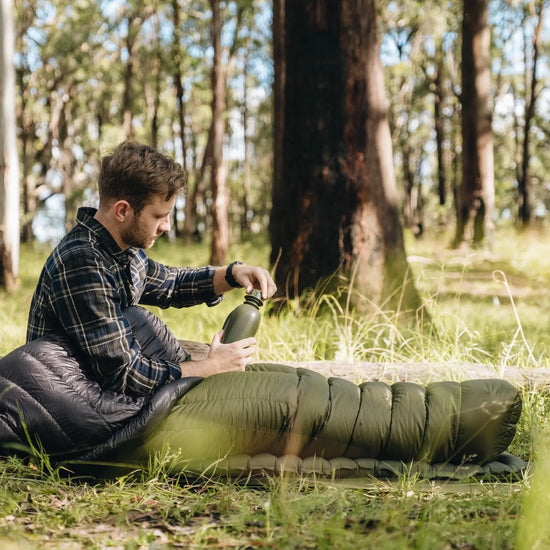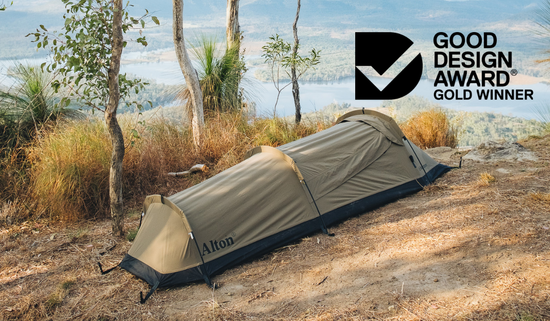Here at Alton, we get asked a lot of questions about all our hiking gear.
But, when it comes to down sleeping bags, there is probably one thing we hear more than anything else…
“How the *bleep* do I wash my sleeping bag?!”
Look, we get it. The idea of washing your down sleeping bag can be stressful.
A sleeping bag is often one of the biggest investments we make in our adventure gear, so it’s only natural that you feel worried about accidentally damaging it by washing it incorrectly.
We are here to help.
In today’s blog, we walk you through why, when and how to wash a down sleeping bag step by step, so you can clean and care for your precious sleeping bag with confidence.
Is it safe to wash a down sleeping bag?
Provided you do it right, it is safe to wash a down sleeping bag. In fact, it is going to help maintain the insulative performance of your sleeping bag for longer.
Why? Well, camping is kinda dirty.
Each time you use it, your sleeping bag comes into contact with grit and grime from the environment, and body. Over time this can cause the down to lose some of its puffiness, reducing loft so it can’t trap as much air to provide insulation.
Washing your sleeping bag removes the build-up of dirt, body oil and other contaminants that accumulate on the outer shell and the filling inside. This can restore the down to peak condition and keep your sleeping bag in good condition for longer.
Are there professional sleeping bag cleaning services?
The idea of finding a professional to wash it for you can be very appealing, especially if you’re intimidated by the idea of washing a sleeping bag at home (or just can’t be bothered!).
However, there are a couple things to keep in mind when looking for a professional sleeping bag cleaning service.
First, sleeping bags (and any down products) should never be dry cleaned.
The dry cleaning utilises chemical solvents that can damage the down and outer shell of your sleeping bag, compromising their performance.
And second, while some professional cleaning businesses also offer down washing services, that doesn’t mean that they have experience with high-performance outdoor gear.
For this reason, it is essential you do your research beforehand.
We recommend that you get in touch first, and don’t be afraid to ask about their experience with outdoor equipment such as sleeping bags and what products they use for cleaning these items… and maybe even what their policies are regarding items damaged during cleaning!
There are a few professional cleaners who specialise in washing sleeping bags and other hiking gear, so that may be a good alternative if you are not keen on cleaning your sleeping bag yourself.

How often should you wash a down sleeping bag?
Ok, we know we said before that washing your sleeping bag is an important part of maintaining its performance over time… but that doesn’t mean you should go washing your sleeping bag after every use.
While never washing your sleeping bag isn’t ideal, you also don’t want to over-wash it.
Down is delicate, so excessive or improper washing technique can have the opposite effect, damaging the structure of the down clusters and decreasing the loft.
Over-washing can also reduce the effectiveness of any hydrophobic treatments used on the down or the outer shell of the sleeping bag.
So how do you actually know if your sleeping bag needs a wash?
The truth is that there are no rules about how often you should wash your sleeping bag.
We’ve heard some people say they wash their sleeping bag a few times a year, and we’ve met other people who say they’ve NEVER washed theirs, even after years of regular use.
To help you out, we have put together a handy quiz to tell if your sleeping bag is due for a wash…
Sleeping Bag Wash Quiz: Is It Time for a Clean?
1. Does your sleeping bag smell funky?
- Not at all, it still smells fresh. (0 points)
- There's a faint odour after I use it, but it fades after airing it out for a bit. (2 points)
- Yep, it definitely has a noticeable smell and it isn’t going away. (3 points)
2. How many nights have you used your sleeping bag in the last 12 months?
- Not many nights at all… I don’t go camping often! (1 points)
- I’ve used it on a few camping or backpacking trips in the last year. (2 point)
- Too many to count… Camping is life! (3 points)
3. Have you noticed any visible dirt or grime on the sleeping bag?
- Nope, it looks good as new. (1 point)
- Maybe a few little grubby spots here and there. (2 points)
- Yes, there are visible dirty marks and grime build-up. (3 points)
4. Does your sleeping bag loft (puff up) as much as it used to?
- Yep, it lofts up nicely. (1 point)
- It’s hard to tell… maybe not quite as much as before. (2 points)
- No, the loft has definitely reduced. (3 points)
5. Do you get sweaty or overheat while you sleep in your sleeping bag?
- Not really… (1 point)
- Occasionally I feel a little clammy, but it's not a major issue. (2 points)
- Yes, I often wake up all sweaty. (3 points)
6. Do you use a sleeping bag liner?
- I always use a sleeping bag liner. (1 point)
- I use a liner occasionally. (2 points)
- No, I don't use a liner. (3 points)
5-8 points: A full wash probably isn't necessary yet. Instead, make sure you’re storing it correctly and give it a little fluff up every now and then between uses.
9-12 points: It might be time to consider a wash. If you’re still not sure, why not give your sleeping bag a gentle spot clean (instructions below) and good air-out first to see if that helps.
13+ points: Your sleeping bag is definitely due for a wash! Dirt, grime, and reduced loft can all be tackled with good clean.
How to wash a down sleeping bag?
In this section, we’ll walk you through the step-by-step process of spot cleaning, washing and drying your goose down sleeping bag.
But first, a few quick words of advice…
- Read through all of the instructions below before you begin. Washing your sleeping bag is like following a recipe. You don’t want to get halfway through only to realise you’re missing a key ingredient!
- Make sure you have the right supplies – don’t start cleaning your sleeping bag until you’re sure that you have everything you need for each part of the process.
- Check your washing machine and dryer are suitable . If your washing machine does not have a gentle wash setting (eg. delicates or wool) or if you have a top-loading washing machine with an agitator, then you will need to handwash your sleeping bag or take it to a laundromat with suitable machines. Same with the dryer - if there is no delicate or cool temperature setting, then you’ll need to find an alternative or air-dry your sleeping bag.
Got all that? Great! Let’s do this.

Step One: Spot Clean Your Sleeping Bag.
This step is all about removing visible signs of dirt and grime from the outer shell material of the sleeping bag.
Depending on how dirty your sleeping bag is, this might be all you need to do.
Or, if you think it’s time to do a full clean, doing a spot clean first to tackle the visibly dirty spots will help you get the best possible end result.
Bonus tip! Try spot cleaning a small, inconspicuous place first, just to make sure everything is working as it should.
What you'll need:
- Down wash or any outdoor gear wash that is suitable for down.
- Soft-bristled brush (a toothbrush works well).
- Lukewarm water
- Cleaning cloth or sponge
Instructions:
Check the care label on your sleeping bag. It is important to check (and follow) and specific instructions listed on your sleeping bags care label.
Inspect your sleeping bag. Have a good look over your sleeping bag and identify any areas that need attention. Down by your feet, along the zipper and at the head opening are areas that typically get more grubby.
Prepare the cleaning solution. Follow the instructions on the cleaning product to prepare your solution. Have everything you need close by.
Apply the cleaning solution. Dip your cleaning brush into the cleaning solution and gently scrub the stain or dirty mark. Avoid saturating the fabric, just focus on the surface of the sleeping bag. This is a spot clean, remember!
Be gentle. Use a circular motion with the soft brush to loosen the dirt or stain. Be careful not to scrub too hard, as this could damage the fabric.
Wipe away all soap residue - or continue on with a full washing! If you’re planning to wash your sleeping bag completely, then you can jump ahead to Part Two. Otherwise, to finish the spot clean, use the damp cloth or sponge to wipe away the soap residue. Again, you’re not trying to get things soaking wet here… just give the area a few good wipes over until it looks clean and soap-free.
Air dry your sleeping bag. Hang the sleeping bag or lay it flat in a well-ventilated area, away from direct sunlight and leave it to dry for at least 24 hours. Give it a gentle shake now and then to fluff up the down.
That’s your spot clean done! Once it is completely dry you can pack it away into your sleeping bag storage sack.

Step Two: Wash Your Sleeping Bag.
Now you have removed any visible signs of dirt or grime on the outside of your sleeping bag, you can proceed with a complete washing process.
Most sleeping bags can be washed in a front-loading washing machine (or a top-loader without an agitator) on a gentle cycle with lukewarm or cold water. You can also hand wash your sleeping bag in a bathtub, but this takes a lot more time and effort. Whichever method you choose, we suggest only washing and drying one sleeping bag at a time.
What you'll need:
- Down wash or any outdoor gear wash that is suitable for down.
- A bathtub or front-loading washing machine.
Instructions:
Consult your sleeping bag’s care label for washing instructions. Many down sleeping bags will come with detailed care instructions, and it is always best to follow the specific advice provided by the manufacturer.
Do your pre-wash prep. Make sure you have everything you need for washing and drying your sleeping bag (explained below in Part Three). Once you’ve got your supplies on hand, go ahead and fully unzip your sleeping bag and loosen any drawcords, turn your sleeping bag inside out and place it in the washing machine or bath tub.
Prepare the cleaning solution. Follow the instructions on the cleaning product to prepare your solution. Some solutions will suggest different volumes depending on whether you’re using a front or top loading washing machine or washing by hand. Note, although it can be tempting to add extra cleaning solution, this is not a good idea. Excess soap will be harder to rinse out and may leave a residue on the down, diminishing the loft and reducing the insulative performance.
Wash your sleeping bag. Wash your sleeping bag according to the care label instructions. If you’re machine washing it, set the machine to a delicate cycle with a luke-warm or cold water (and adjust the settings to use extra water if possible). If you’re washing by hand, submerge the sleeping bag in a bathtub of lukewarm water with the cleaning solution. Allow the sleeping bag to soak for 1hr before gently kneading and agitating it by hand, focusing on the areas that seem particularly dirty.
Rinse your sleeping bag. If you’re using a washing machine, the rinse cycle should happen automatically on a delicate cycle. However, if you think there may still be soap residue, you can adjust the settings to add an extra rinse cycle (making sure it’s still set to delicate) or run it through another delicate cycle without any cleaning solution. If you’re washing by hand, empty the bathtub and refill it with clean water and gently agitate your sleeping bag. Repeat this 3-4 times until the water remains clear and soap-free.
Get ready to dry your sleeping bag. Gently remove it from the washing machine or bathtub, pressing out the excess water before you lift it. Be very careful not to pull, drag or tug on your sleeping bag while it is wet, as this can cause damage to the seams. Instead, bundle it up so you can support all of it.
Step Three: Dry Your Sleeping Bag.
Drying your sleeping bag thoroughly is absolutely essential for maintaining the insulative properties of the down.
For a down sleeping bag, the drying process is long… Even using a tumble dryer on low heat can take a few hours, then at least 24 hours air drying after that. Air-drying it without the use of a tumble dryer can take even longer.
If you do decide to air-dry your sleeping bag, we highly recommend doing this when the weather is warm and dry. Air-drying your sleeping bag in cold, humid conditions can add a lot of time to the drying process or may even put your sleeping bag at risk of mould and mildew growth.
If you do want to use a tumble dryer, consider using a dryer at a laundromat as the commercial machines are usually bigger, giving your sleeping bag extra space to fluff up. However, go in prepared with a book or other entertainment to keep you occupied while you wait… it’s going to take a while! But as slow and boring as it may be, don’t take shortcuts like trying to use a higher heat to dry your sleeping bag as this can damage the down and outer shell fabric.
What you'll need:
- 3-5 tennis balls or purpose-made down drying balls
- A tumble dryer (optional)
- A dry, well ventilated place to air-dry your sleeping bag away from direct sunlight
Tumble Dry Instructions:
Check the care label – again! As with every part of this process, if your sleeping bag’s care label provides specific instructions about how to dry it, then it is best to stick to that.
Tumble dry your sleeping bag with 3-5 tennis balls or drying balls. Place your sleeping bag in the dryer and throw in your tennis balls or down drying balls. Set the machine to a gentle, cool drying setting… and wait.
Check on the drying progress every 20-30 minutes. Every 20-30 minutes, have a look at your sleeping bag. As it dries, the down will begin to loft up again, filling the baffles, but if you notice any areas that are still clumpy, gently shake or fluff this area before starting the drying cycle again. It typically takes at least an hour and half to dry a down sleeping bag, but depending on how much down it has and the size of your dryer, it may take double that.
Once dry, dry again. After tumble drying, your sleeping bag should look and feel dry and fluffy, with no clumps of down inside. However, that doesn’t mean it’s ready to pack up just yet. We recommend leaving your sleeping bag out to dry for at least 24 hours, either by hanging up or laying on the ground in a dry, well-ventilated spot away from direct sunlight. During this time, occasionally fluff it up or flip it over, making sure there are no sneaky damp spots. This ensures that your sleeping bag is 100% dry before going back into storage.
Air-Dry Instructions:
Prep your drying station. Our recommended way to air-dry your sleeping bag is to lay it out flat over one or more drying racks with narrow gaps between rungs, as this will ensure that all of your sleeping bag is supported and puts less strain on the seams. Place your drying racks side by side in a warm, well-ventilated place with low-humidity and away from direct sunlight.
Press any remaining water out of your sleeping bag – but don’t overdo it! Squeeze the excess water out of your sleeping bag by pressing it down into the bathtub or squeezing it together into a ball – but be very, very gentle here! Don’t pull, twist or wring out your sleeping bag, as this can damage the down or rip the seams of internal baffles.
Drape the sleeping bag on your drying station. Carefully position your sleeping bag over the racks, adjusting as needed to ensure that as much of the sleeping bag is supported as possible. Now, you wait!
Give it a fluff-up every few hours. Once your sleeping bag is partially dry (slightly damp but no longer dripping with water), give it a gentle shake to fluff up the down and turn it over on the rack. This helps to break up any clumps of down and ensure that everything is drying evenly. Repeat this every few hours until no clumps remain and the entire sleeping bag is completely dry.
Let it air-out for another 24hrs. Even if your sleeping bag seems completely dry, it is still a good idea to leave it out to breathe for at least another 24 hours or more, just to be completely sure that there are no sneaky little spots of damp remaining. Once you’re satisfied that it’s as dry and fluffy as it’s going to get, you can put it back into your sleeping bag storage sack.
All Done! Your Down Sleeping Bag Is Clean.
Alright, you’ve done it! That wasn’t so bad, was it?
Remember, this guide to caring for a down sleeping bag is based on industry-standard care instructions, but it is essential that you check your sleeping bag care label for specific cleaning instructions – and follow them.
If you’re unsure about any aspect of cleaning your sleeping bag, it is best to reach out to the manufacturer directly and ask for their advice.


